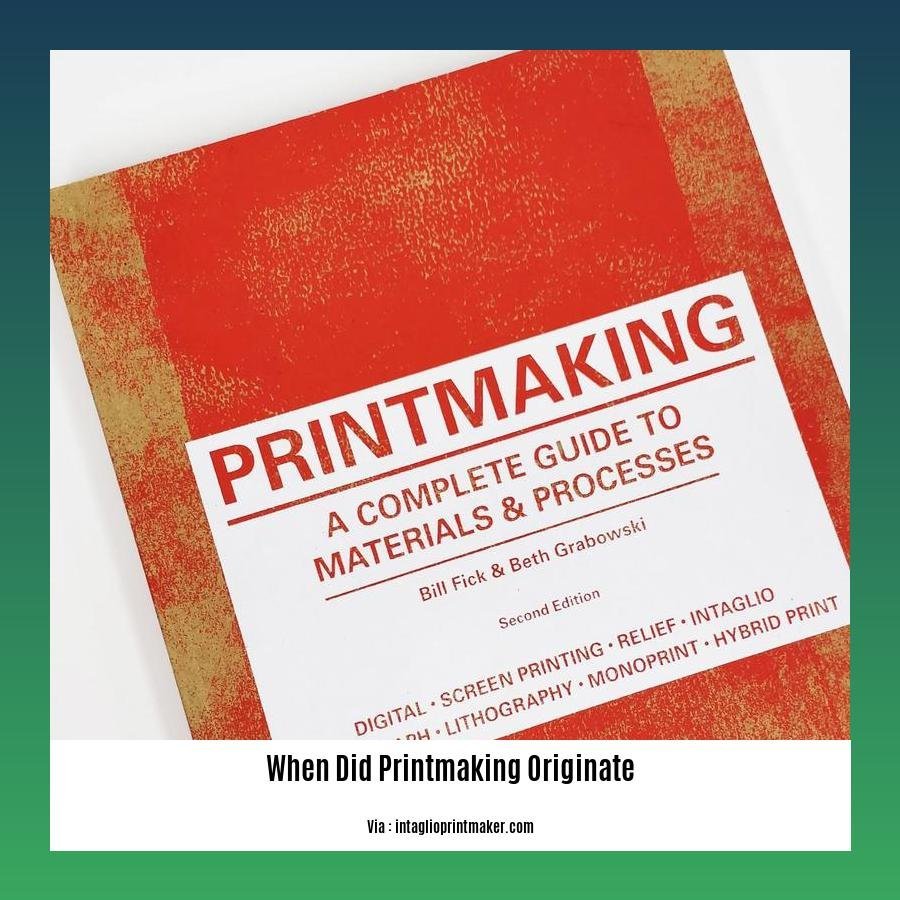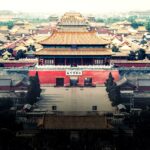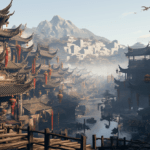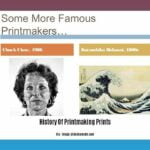Embark on a captivating journey through time as we delve into the origins and evolution of printmaking in [When Did Printmaking Originate and How Has It Evolved Over Time?]. Discover how this transformative art form, rooted in ancient traditions, has flourished over centuries, leaving an indelible mark on the world of art and visual expression.
Key Takeaways:
The origins of printmaking can be traced back to the Sumerians, who etched designs and cuneiform inscriptions on cylinder seals around 3000 bce.
The earliest known example of printmaking is a woodblock print on silk from the Han Dynasty in China.
The invention of movable type and paper in China facilitated the production of the first book printed from movable type in Korea during the 14th century.
Printmaking became mechanized in Europe during the 15th century, transforming the art form and revolutionizing the printing process.
When Did Printmaking Originate?
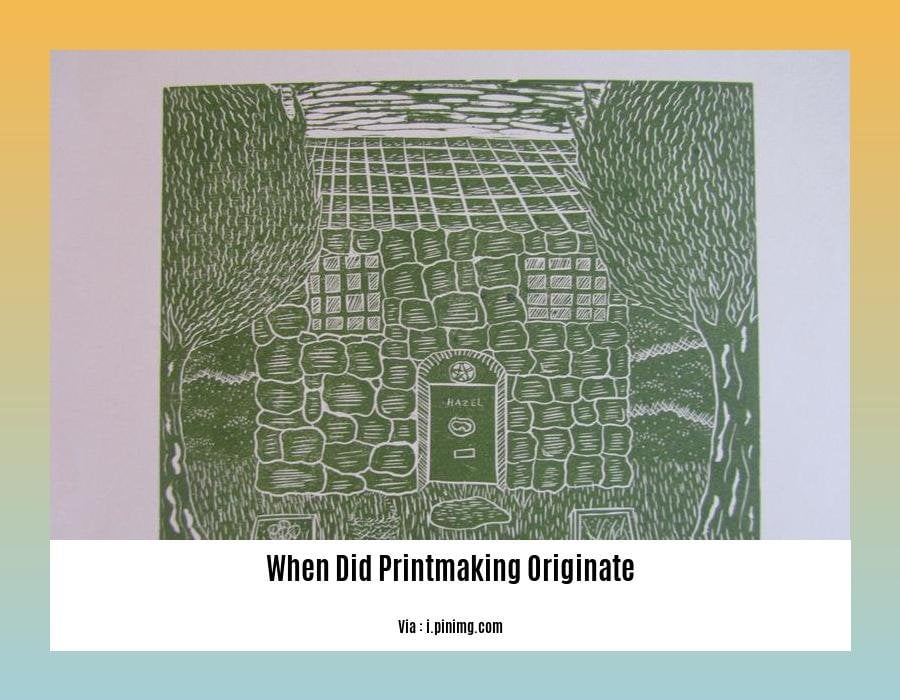
The fascinating history of printmaking dates back to ancient civilizations, with its roots in the very fabric of human creativity and expression. When Did Printmaking Originate? Let’s dive into the captivating journey of this art form.
Sumerian Seals and the Dawn of Printmaking
In the lands of ancient Sumer, around 3000 BCE, a remarkable form of printmaking emerged: the cylinder seal. These cylindrical stones, intricately carved with designs and cuneiform inscriptions, served as personal seals for authentication and record-keeping. The act of rolling the seal onto clay created distinctive impressions, leaving an indelible mark on history. These early examples showcase the origins of printmaking, demonstrating the technique’s ability to replicate images and convey information.
Han Dynasty Woodblock Prints: China’s Artistic Legacy
In the heart of China during the Han Dynasty (206 BCE to 220 CE), printmaking took a significant leap forward. Woodblock printing, a technique that would profoundly impact the world, was born. Artists carved intricate designs and characters onto wooden blocks, which were then inked and pressed onto paper or silk, producing stunning prints in various colors. These woodblock prints encompassed religious, cultural, and artistic themes, providing glimpses into the rich tapestry of Chinese history and culture.
The Gutenberg Revolution: Printing Transformed
The 15th century ushered in a transformative era for printmaking, marked by the invention of the printing press in Europe. As one of the most significant advancements in human history, the printing press, masterminded by Johannes Gutenberg, revolutionized the production of books and printed materials. This technological marvel enabled mass production, facilitating the dissemination of knowledge, ideas, and artistic expression on an unprecedented scale. The Gutenberg Bible, printed around 1455, stands as a testament to this transformative invention.
Modern Printmaking: A Tapestry of Innovation
Over the centuries, printmaking continued to flourish, evolving into a diverse and dynamic art form. Artists experimented with various techniques, pushing the boundaries of creativity and expression. From engraving and etching to lithography and serigraphy, printmaking encompasses a wide spectrum of processes that produce stunning visuals. Today, printmaking remains a vibrant and cherished art form, with contemporary artists finding new and innovative ways to explore the medium’s rich potential, creating works that captivate and inspire.
Printmaking has left an indelible mark on our world, enhancing our understanding of history, art, and culture. This fascinating journey, from ancient seals to modern masterpieces, continues to inspire and captivate as we explore the origins and evolution of printmaking – an art form that has indelibly shaped the human experience.
Uncover the fascinating history of printmaking prints and delve into the intricacies of this captivating art form.
Discover the surprising answer to the question: Are prints of paintings worth anything? Get the facts and make informed decisions about your art collection.
Explore the intriguing inquiry: Are original prints valuable? Gain insights into the factors that determine the worth of original prints and find hidden gems among your collection.
Embark on a journey through history of printmaking in art, tracing the evolution of this artistic medium from its humble beginnings to its modern-day resurgence.
Delve into the significance of why is printmaking important in our society? Appreciate the role of printmaking in shaping our cultural heritage and its impact on contemporary artistic expressions.
The invention of the printing press by Johannes Gutenberg in the mid-15th century, revolutionizing the production of books and prints.
Gutenberg’s innovation revolutionized the world of printmaking by introducing the concept of movable type printing. This ingenuity transformed the painstaking process of hand-copying manuscripts into a streamlined mass production of printed materials, forever altering the course of information dissemination.
Key Takeaways:
Gutenberg’s breakthrough enabled the mass production of books, pamphlets, and newspapers, democratizing access to knowledge and ideas.
The printing press accelerated the spread of knowledge, revolutionizing cultural, intellectual, and religious landscapes.
Gutenberg’s invention facilitated the dissemination of scientific discoveries, fueling advancements across various disciplines.
It fostered the growth of literacy, empowering individuals to actively participate in societal dialogues and challenge prevailing norms.
Printed materials, now accessible to the masses, played a crucial role in shaping public opinion and driving social change.
Citation:
The rise of mass-produced prints for commercial and advertising purposes during the 19th century
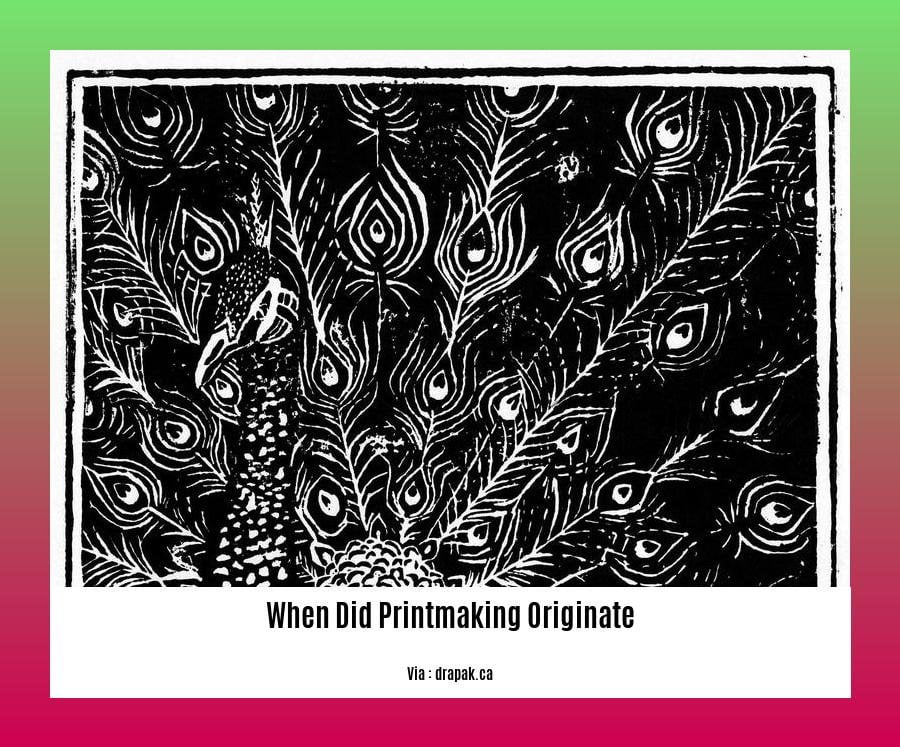
In the 19th century, the world witnessed a surge in mass-produced prints for commercial and advertising purposes. This phenomenon had a profound impact on popular culture, communication, and the dissemination of information. Let’s delve into this chapter in printmaking’s history:
Key Takeaways:
- The 19th-century printing revolutionized printmaking, enabling mass production and transforming industries.
- Steam-powered and rotary presses accelerated printing speed and reduced costs, making prints widely accessible.
- Color printing techniques, such as chromolithography, bloomed, enhancing visual appeal and engaging audiences.
- Advertising embraced printmaking, creating captivating posters, product catalogs, and promotional materials.
- Political propaganda leveraged printmaking to influence public opinion and shape ideologies.
During this period, advances in printing technology, notably the steam-powered press and the invention of the rotary press, significantly boosted the speed and efficiency of the printing process, making mass production a reality. As a result, printed materials became more affordable and accessible to the general public.
The development of color printing techniques, particularly chromolithography, further revolutionized the printmaking landscape. This method allowed for the production of vibrant and visually stunning prints with multiple colors. It became widely used in advertising, posters, book illustrations, and other forms of popular media, captivating audiences with its eye-catching imagery.
The 19th century also saw a surge in the use of printmaking for commercial and advertising purposes. Businesses recognized the power of printed images to capture attention and promote their products and services. They commissioned artists to create posters, product catalogs, and other promotional materials that enticed potential customers. These prints often employed bold colors and compelling imagery to make a lasting impression.
In addition to commercial applications, printmaking played a crucial role in political propaganda during the 19th century. Governments and political parties utilized printmaking to disseminate their messages, influence public opinion, and shape political ideologies. Political posters and caricatures became powerful tools for swaying voters and shaping public discourse.
1. Printmaking Techniques Used in the 19th Century
2. The Rise of Mass-Produced Prints in the 19th Century
The emergence of contemporary printmaking techniques and the use of digital technologies in the 20th and 21st centuries.
In the realm of art, printmaking has undergone a remarkable transformation in the 20th and 21st centuries, characterized by a surge of contemporary techniques and the harmonious fusion of digital technologies. This dynamic evolution has reshaped the boundaries of printmaking, propelling it to new heights of creativity and expression.
Key Takeaways:
- Digital Revolution: The advent of digital technologies has empowered printmakers to explore uncharted territories of artistic possibilities.
- Expanded Techniques: Contemporary printmaking encompasses a wide range of techniques, including digital printing, laser engraving, and 3D printing, allowing artists to produce diverse and innovative works.
- Cross-Pollination of Art Forms: The integration of digital technologies has fostered cross-pollination between traditional printmaking and other art forms, resulting in hybrid techniques and interdisciplinary collaborations.
The Digital Canvas:
The 20th century witnessed the emergence of digital printing, a revolutionary technique that transformed printmaking by utilizing computer-generated images. This innovation opened up a world of limitless possibilities, enabling artists to manipulate and enhance their designs with unprecedented precision and flexibility.
Beyond Traditional Boundaries:
Digital technologies have propelled printmaking beyond its traditional boundaries, allowing artists to explore unconventional materials and surfaces. From printing on metal, plastic, and fabric to creating three-dimensional prints, the possibilities are endless.
3D Printing’s Impact:
The advent of 3D printing has dramatically impacted the realm of printmaking. This cutting-edge technology enables artists to create three-dimensional objects directly from digital files, blurring the lines between printmaking and sculpture.
Collaborative Creativity:
The integration of digital technologies has facilitated collaborative efforts among artists, allowing them to transcend geographical and disciplinary boundaries. Online platforms and shared digital tools have fostered a vibrant community of printmakers, promoting knowledge sharing and collective experimentation.
Digital Preservation and Accessibility:
Digital technologies have revolutionized the preservation and accessibility of printmaking works. High-resolution scans and digital archives ensure that rare and valuable prints can be preserved for future generations while also making them accessible to a wider audience through online exhibitions and virtual museums.
In conclusion, the 20th and 21st centuries have witnessed a dynamic transformation in printmaking practices. The integration of digital technologies has expanded the boundaries of artistic expression, facilitated cross-pollination between art forms, and fostered a collaborative, global community of printmakers. As technology continues to advance, it is exciting to imagine the future possibilities and innovations that await this ever-evolving art form.
Sources:
- The Digital Revolution in Printmaking
- Contemporary Printmaking Techniques
FAQ
Q1: When did printmaking originate?
A1: The earliest known examples of printmaking date back to the Sumerians, who engraved designs and cuneiform inscriptions on cylinder seals around 3000 BCE.
Q2: What were some early printmaking techniques?
A2: Early printmaking techniques included woodblock printing, which was commonly used in Japanese Ukiyo-e prints, and lithography, which relies on the principle that oil and water do not mix.
Q3: How did the invention of the movable-type printing press impact printmaking?
A3: Johannes Gutenberg’s invention of the movable-type printing press around 1440 revolutionized printmaking by enabling the mass production of uniform printed materials, primarily text, in the form of books, pamphlets, and newspapers.
Q4: What were some innovations in printmaking during the 19th century?
A4: The 19th century witnessed significant advancements in printing technology, including steam-powered presses, the invention of the rotary press, and the development of chromolithography, a technique for producing multi-colored prints.
Q5: How has digital technology influenced printmaking?
A5: In contemporary times, digital technology has transformed printmaking by allowing artists to create and share works using digital tools and software, resulting in new and innovative expressions that combine traditional and digital techniques.
- Star Ring Trends: Etsy vs Amazon - March 28, 2025
- Boost Pollinator Habitats: Baby Blue Eyes Sustainable Farming Guide - March 28, 2025
- Protect Big Black Bears: Effective Conservation Strategies - March 28, 2025
